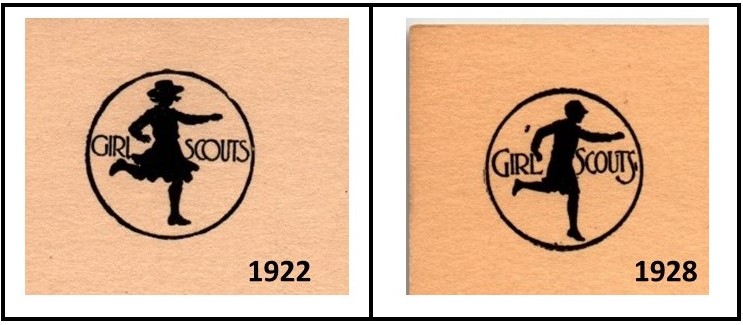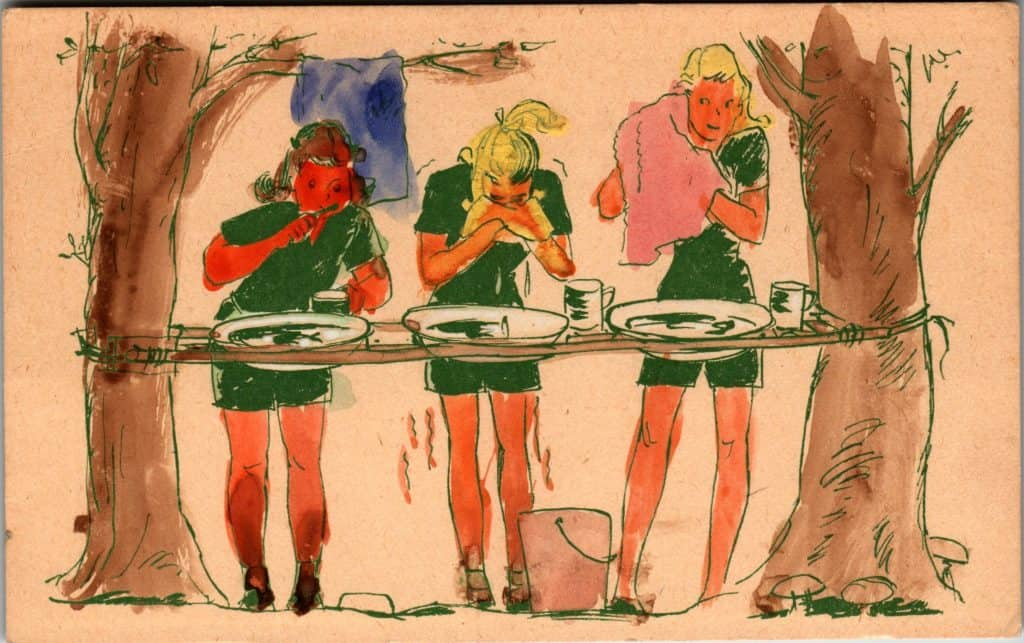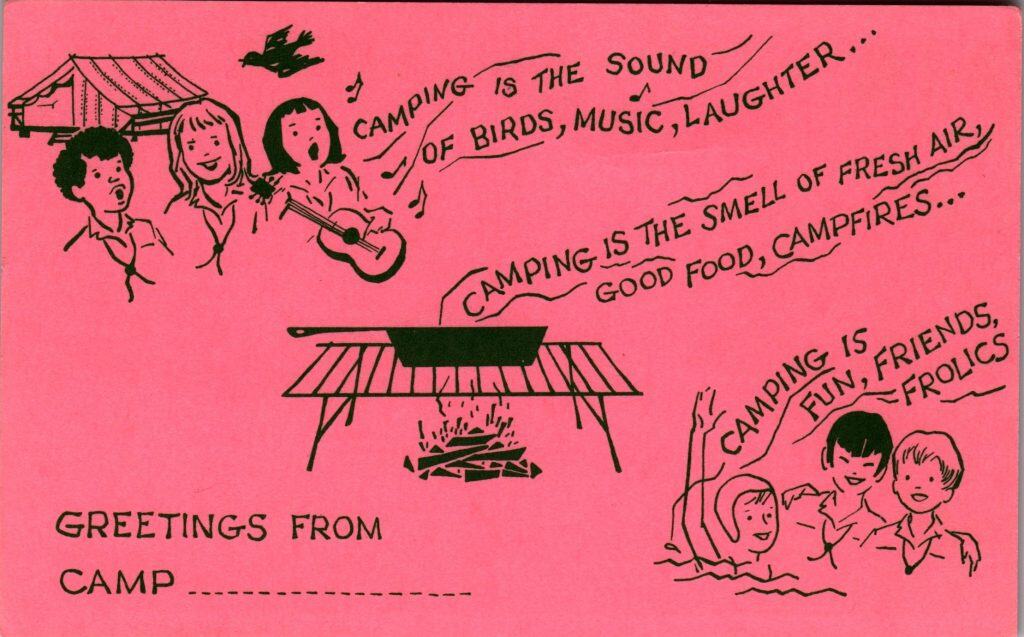The Girl Scouts of USA (GSUSA) published postcards for the girls to send home from camp for many years and still do. The Girl Scouts was founded in 1912 [See Postcard History article, Girl Scouts: a history, by Clarissa Ferraris, published on January 14, 2024]. That article points out that building character is a moral goal for many fraternity and sorority organizations that exist for people of all age groups. The Girl Scouts of USA is one of the best and certainly among the successful organizations to use postcards to document their mission.
In the Girl Scouts Collector’s Guide we can find a list of postcards published before the 1980s . . .
- 1920-1925 – The first postcard was a postal card with just a GS symbol.
- 1922: a set of six silhouette postcards designed by Jean Gillespie (see below).
- 1924-1929: a set of four postcards depicting the four seasons designed by Edith Ballinger (very rare).
- Postcards (at least seven) showing the Girl Scouts Promise & Law.
- A set of three postcards showing the various levels for Brownie in the 1930s.
- A set of 127 postcards related to camping, published from 1936 to 1973 (See examples below).
- Other sets were published and are still being published celebrating Thinking Day or the conventions.
This essay will concentrate on two sets of postcards related to camping – the silhouette set by Jean Gillespie and the 127 postcards related to camping.
In 1922 and 1928, GSUSA published two set of postcards (6 each) by designer Jessie Gillespie. Her full name would be Jessie Gillespie Willing, but usually signed JG. She did not use her last name Willing because her father, Thornton Willing, was well known in the art world. She was an American magazine and book illustrator. She was also a life member of the National Arts Club. Her specialty was using silhouettes to express her imagination. GSUSA used her talent on postcards but also on handbooks and pamphlets.
Here are two postcards (No. 1 and 2) that look identical at first glance, but they were published in 1922 and 1928 respectively. Look closely at the hat of the girl kneeling near the fire! The hats are different; one is a brimmed hat, the other is a modern cloche style. Thus, we have two sets of six postcards that can only be distinguished easily by the logo on the back of the postcard. (See comparison illustration below.)

Notice in these logos, not only the hat was changed but also the dress of the girls. This was to conform with the GSUSA changes in uniforms in 1928.
Starting in 1936, GSUSA started publishing sets of postcards that would depict, often in comic ways, the girls’ life at camp. They were provided for the girls to send home and many girls did, as it is easy to find them with messages and postally used. The 1936 postcards have the new logo for GSUSA on the back as a Trefoil but not always. The number of postcards published each year until 1973 varies. It started with eight postcards each year and ended up with four not even every year.
Very few postcards were signed by the designer, but they all have a similar style. As some are signed by different illustrators, it is believable that GSUSA might have provided the illustrators with clear instructions.
Until about 1937, the picture on the front allowed writing on the front as well as on the back. From 1936, one card shows a Girl Scout in trouble in the woods, yet another shows that the girls are skilled in First Aid necessities.
In 1939, there were three postcards signed by E.D., and five signed by Duvall.
Until 1950, eight postcards were published each year. This postcard shows how one girl decided to add color to the image before mailing it to her parents in 1943.

A girl dreams of ice cream in the middle of the night, designed by Hagg. Notice the owl watching the scene. The owl is a symbolic animal in Girl Scout lore. It represents wisdom.

World War II did not affect the production of eight postcards each year, but starting in 1947, eight postcards were published every two years. Starting in 1958 only four postcards were published, and they were to be used for four years. In 1953, the paper was no longer just tan and nor did the backs have cartoons. The illustrations below, Card #10 and #11show some of the backs, from 1951 and 1962 respectively. Notice the illustration for the stamp box: “Stamp here” with a little bunny or two feet.
The paper color poses a dilemma for the collector as the same postcard was published on various colored paper. Should all colors variation be collected?
Examples of the different colored paper: blue, green and pink.

The cards on colored card stock were published in 1953, 1962 and 1969 respectively.
It is certainly not surprising that these many postcards about camping and the adventures that the girls experienced are remembered on so many postcards. Camping is a very important component of being a Girl Scout and has been since the GSUSA was established by Lord Baden Powel and Juliette Low.










Clarissa – Congratulations on another informative, perfectly organized and enjoyable article.
Thanks for another great article. as a postcard dealer I enjoy learning about various topics that the production of cards like these.
These are great. I had no idea they existed.
Very interesting article full of facts that I did not know. Thanks!
Thanks for a swell article. Love all of the illustrations and the “How To Collect” and how you explained the early sets and series. Just Great!!.
The hand coloring of Card No.8 was done so well that I wouldn’t have realized it was a “custom job” had you not revealed that fact!
Thanks so much for the great article, Clarissa. So many interesting subjects covered on postcards!